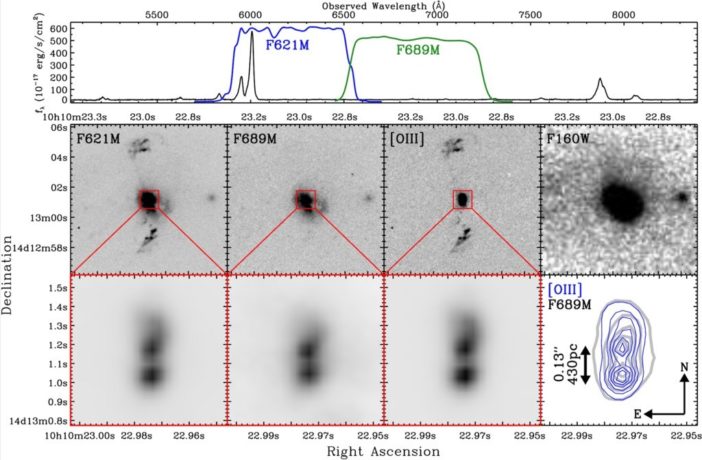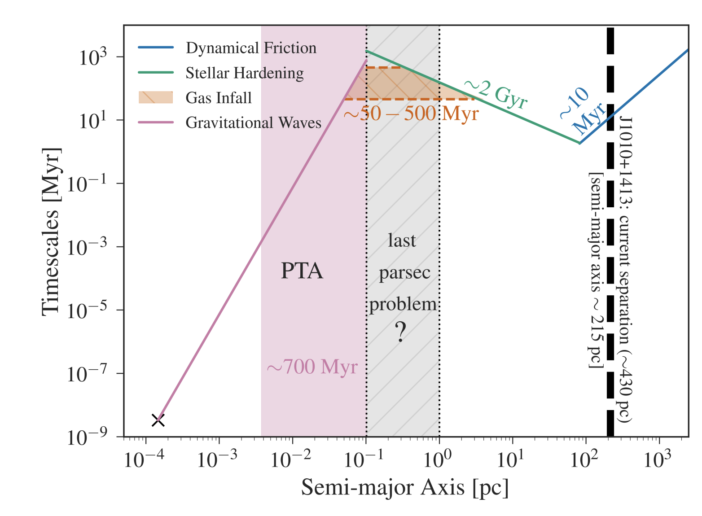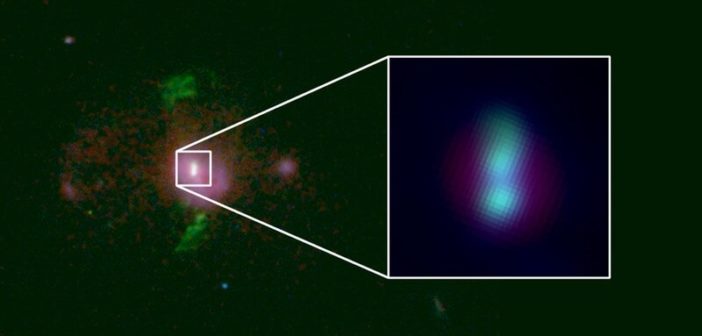Editor’s note: Astrobites is a graduate-student-run organization that digests astrophysical literature for undergraduate students. As part of the partnership between the AAS and astrobites, we occasionally repost astrobites content here at AAS Nova. We hope you enjoy this post from astrobites; the original can be viewed at astrobites.org.
Title: Discovery of a close-separation binary quasar at the heart of a z ∼ 0.2 merging galaxy and its implications for low-frequency gravitational waves
Authors: Andy D. Goulding, Kris Pardo, et al.
First Author’s Institution: Princeton University
Status: Published in ApJL
With the announcement of the experimental confirmation of gravitational waves by LIGO in 2016 in tandem with additional electromagnetic follow-up of a neutron-star merger, astronomy was quickly ushered into an era of truly multi-messenger science. Although the number of gravitational-wave events observed by LIGO since is already substantial, the sheer number of black holes (and neutron stars) predicted to exist within our universe vastly outweighs this cumulative yield. One reason why LIGO is not constantly finding strong gravitational waves from all of these black holes (the gravitational wave background or GWB) is that not every black hole exists in a pair, which is a necessary condition to spiral inwards, merge, and set off a gravitational-wave event. Predictions suggest that the timescales required for some of these events to occur are a sizable fraction of the age of our universe!
LIGO has, however, shown direct evidence for the merging of solar-mass black holes with atypically large masses between 10–40 M☉, and although easier to observe due to their strong gravitational signal, their existence has continued to challenge theoretical explanations. Scaling up to even greater masses does not reduce the pressure on theory either, as the predicted dominant mass contribution to the yet undetected GWB is from supermassive black holes (SMBHs) on the order of 108–109 M☉.

Figure 1: Hubble Space Telescope images of SDSS J1010+1413, showing wide-field galaxy morphology and a zoom-in view of the central SMBH pair with the F621M, F689M, [OIII], and F160W bands. The galaxy shows evidence of a past merger: a disturbed shape and stripped gas streams. The [OIII] extent is seen to be coincident with the continuum F689M light. [Goulding et al. 2019]
Putting the final parsec problem aside, the authors of today’s astrobite provide definitive evidence for a precursor system that may one day produce a low-frequency gravitational-wave event consistent with a strong contribution to the GWB.
As shown in Figure 1, observations with the WFC3 instrument aboard the Hubble Space Telescope revealed a pair of tightly bound SMBH candidates in a highly luminous post-merger galaxy, poetically named “SDSS J1010+1413”. Accounting for the cosmological distance, the separation between the SMBHs is found to be ~430 pc (1,400 light-years). Previous studies examining the velocities and dynamics of the galaxy confirm the outward telltale signs of a trainwreck galaxy and provide the context for the apparently resolved pair of SMBHs in its core. Special imaging with an appropriate [OIII] narrowband filter corroborates this picture by defining the extent of the extremely luminous [OIII] emission — characteristic ionized gas associated with powerfully accreting SMBHs (AKA quasars). However, coincident X-ray observations with the Chandra Space Telescope showed very little X-ray light, a fact that, when compared to infrared estimates, suggests an obscuring cloud of thick gas along the line of sight.
Despite the awesome resolution of the Hubble Space Telescope (~0.04”), such an observation of a supposed SMBH pair may be ambiguous. To increase confidence in this interpretation, the authors modeled each of the sources with a coincident point-like model and an extended Gaussian model. Even so, a single SMBH with extended [OIII] and bisecting obscuration due to a dust lane could mimic this scenario, albeit with a significantly worse fit. Given the former scenario, each SMBH is estimated to have a minimum mass of 4 x 108 M☉ based on the Eddington luminosity limit, putting them in the sweet spot of GWB contribution.

Figure 2: Merger stages with timescales shown. From the right, dynamical friction accelerates the first stage of coalescence, followed by stellar hardening. Gas infall may help prevent stall-out and overcome the “last parsec problem”. Then, in the final stages of coalescence at < 1 pc, Pulsar Timing Arrays should be sensitive to the predicted nanohertz gravitational-wave signal prior to the merger. [Goulding et al. 2019]
The low-frequency nanohertz GWB signal will not be detectable by current observatories such as LIGO. However, these increasingly powerful facilities will soon be complemented by hyper-sensitive Pulsar Timing Arrays which should be able to detect a nanohertz GWB signal, as may be produced by such a pair of quasars in this and other trainwreck galaxies.
About the author, John Weaver:
I am a PhD student at the Cosmic Dawn Center at the University of Copenhagen, where I study the formation and evolution of galaxies across cosmic time with incredibly deep observations in the optical and infrared. I got my start at a little planetarium, and I’ve been doing lots of public outreach and citizen science ever since.
